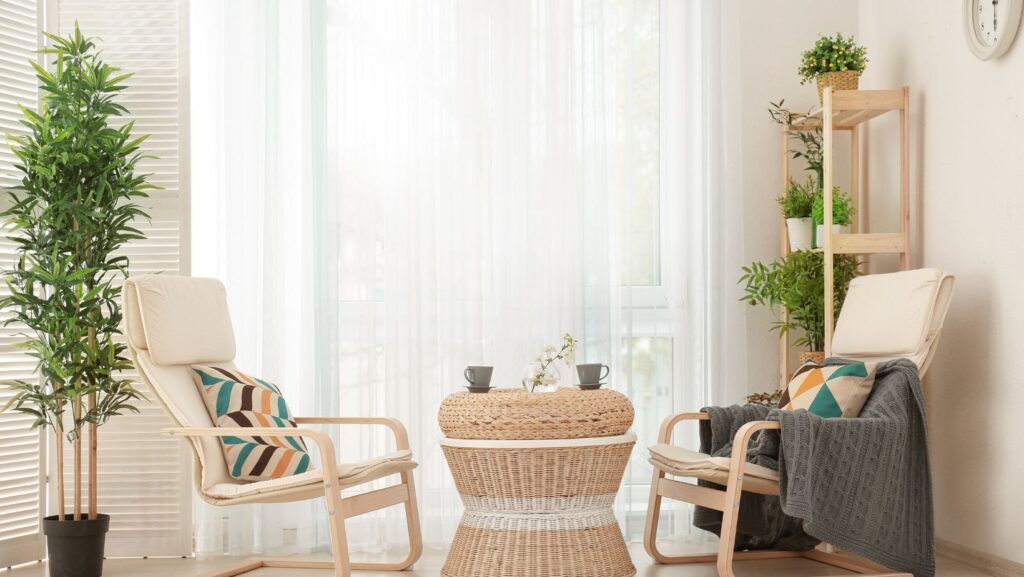The era of sleek lines and sparse decor is slowly fading, and a new style is taking centre stage in homes across the globe: Comfort Design. This trend, a cosy blend of Cottagecore and Granny Chic, is all about creating a space that feels as inviting as a warm hug. More than just an aesthetic shift, Comfort Design taps into the deep human need for a sanctuary that feels secure, warm, and lived-in.
What is Comfort Design?
Comfort Design is a hybrid style that pulls the best elements from two already-beloved interior design movements: Cottagecore and Granny Chic.
Cottagecore embraces pastoral simplicity, drawing inspiration from countryside living, soft fabrics, vintage furnishings, and floral patterns. It’s about crafting a space that feels quaint, natural, and slightly whimsical.
Granny Chic takes the charm of a grandmother’s home – think crochet blankets, embroidered pillows, and patterned wallpaper – and elevates it with a modern twist. It’s about nostalgia with an edge, blending retro pieces with contemporary accents to create a quirky, layered look.
Comfort Design combines these two movements, resulting in interiors that are both cosy and sophisticated. Imagine floral wallpaper meeting modern armchairs, plush sofas paired with lace doilies, and vintage lamps illuminating comfortable, textured throws. It’s more than just design; it’s creating spaces that feel personal, welcoming, and filled with soul.
Why Has Comfort Design Taken Over in 2024?
- An Escape From Minimalism: For years, minimalism dominated the interior design world. Clean lines, neutral palettes, and sparse decorations were the go-to aesthetic, representing clarity and order. But as our world has become more unpredictable, many are finding minimalism too cold and impersonal. People now crave warmth, character, and personal history in their homes – Comfort Design is the perfect antidote.
- The Rise of Nostalgia: Nostalgia is a powerful force. Comfort Design speaks to our longing for a simpler, more comforting time. The familiar patterns, hand-crafted items, and vintage pieces evoke memories of childhood, family, and tradition, making spaces feel emotionally rich. Consider a soft vintage rug spread across a warm wood floor. The influence of Granny Chic brings these elements into modern homes, offering a sense of connection to the past while remaining stylish.
- Personalisation is Key: Unlike minimalism, which often strips spaces down to their bare essentials, Comfort Design thrives on layers. It invites you to add personality and warmth through meaningful items. Whether it’s a handmade quilt from a family member, vintage teacups from an antique store, or whimsical floral prints that remind you of your favourite garden, each item contributes to the room’s story. Every space becomes a reflection of the homeowner’s life, full of unique details.

- Softness in Textures: Comfort Design places heavy emphasis on tactile experiences. Plush textiles, warm wood, soft lighting, and layered fabrics are essential to the overall feel of the room. Wool blankets, velvet cushions, and hand-knitted rugs add a sense of softness and warmth that minimalism often lacks. It’s not just about how a room looks; it’s about how it feels.
Achieving the Look
- Floral Prints: Wallpaper or fabric with delicate floral designs immediately brings a vintage, Cottagecore feel. Think soft, nature-inspired colours – muted pastels or warm earthy tones that create a gentle, inviting atmosphere.
- Vintage and Upcycled Furniture: Sourcing older furniture pieces, whether they’re family heirlooms or treasures found at flea markets, is a cornerstone of Comfort Design. Pair these with an antique-style floor such as engineered oak parquet. These items add character and a sense of history to a space.

- Textured Layers: Combine materials like wool, velvet, linen, and cotton for a rich, layered effect. Think quilts, crochet blankets, and embroidered cushions that invite you to sink in and get cosy.
- Handcrafted Accessories: Artisan-made accessories, like ceramics and woven baskets, add an extra layer of warmth and authenticity. Incorporating handcrafted elements emphasises the personal and thoughtful nature of Comfort Design.
- Lighting:Lighting should be soft and inviting. Use vintage-style lamps with warm bulbs, candles in decorative holders, or even fairy lights for a soft, ambient glow that creates a serene, calming environment.
Why Comfort Design is Here to Stay
Comfort Design isn’t just a passing trend – it’s a response to the current times. With the world outside feeling uncertain, people are increasingly turning inward, making their homes spaces of refuge and relaxation. It’s about more than just aesthetic appeal; it’s about fostering a sense of well-being and belonging.
So, if you’re ready to trade in your minimalist living room for a space that feels like a cosy retreat, now’s the time to embrace the soft, inviting world of Comfort Design – because who doesn’t need a little extra comfort right now?



